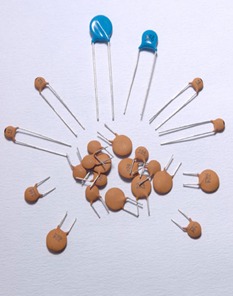A capacitor or condenser
is a passive electronic component consisting of a pair of conductors separated
by a dielectric. When a voltage potential difference exists between the
conductors, an electric field is present in the dielectric. This field stores
energy and produces a mechanical force between the plates. The effect is
greatest between wide, flat, parallel, narrowly separated conductors.
An
ideal capacitor is characterized by a single constant value, capacitance, which
is measured in farads. This is the ratio of the electric charge on each
conductor to the potential difference between them. In practice, the dielectric
between the plates passes a small amount of leakage current. The conductors and
leads introduce an equivalent series resistance and the dielectric has an
electric field strength limit resulting in a breakdown voltage.
The properties of capacitors in a circuit may determine the resonant frequency and quality factor of a resonant circuit, power dissipation and operating frequency in a digital logic circuit, energy capacity in a high-power system, and many other important aspects
A capacitor (formerly known as condenser) is a device for storing electric charge. The forms of practical capacitors vary widely, but all contain at least two conductors separated by a non-conductor. Capacitors used as parts of electrical systems, for example, consist of metal foils separated by a layer of insulating film.
Capacitors
are widely used in electronic circuits for blocking direct current while
allowing alternating
current to pass, in filter networks, for smoothing the output of power
supplies, in the resonant circuits that tune radios to particular frequencies
and for many other purposes.
A
capacitor is a passive electronic component
consisting of a pair of conductors separated by a dielectric (insulator). When
there is a potential difference (voltage) across the
conductors, a static electric
field develops in the dielectric that stores energy and produces a mechanical
force between the conductors. An ideal capacitor is characterized by a single
constant value, capacitance,
measured in farads.
This is the ratio of the electric
charge on each conductor to the potential difference between them.
The
capacitance is greatest when there is a narrow separation between large areas
of conductor, hence capacitor conductors are often called "plates",
referring to an early means of construction. In practice the dielectric between
the plates passes a small amount of leakage current and also has an electric
field strength limit, resulting in a breakdown voltage,
while the conductors and leads introduce an undesired inductance and resistance.

